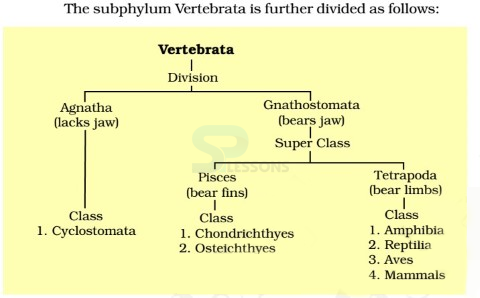 Introduction
Introduction
Vertebrates represent the overwhelming majority of the phylum Chordata. The Vertebrata, or vertebrates, constitute a diverse group of animals that includes fish, amphibians, reptiles, mammals, and birds. These organisms all possess a vertebral column, or backbone, that runs from head to tail and surrounds and protects the main nerve cord. Perhaps the most important vertebrate feature is the presence of embryonic neural crest cells, which give rise to many important nerves as well as to head and facial features.
 Vertebrata
Vertebrata
Division in vertebrata
Image: vertebrata
Source: NCERT Text Books
Viviparous and Oviparous Animals • We have learnt that some animals give birth to young ones while some animals lay eggs which later develop into young ones. The animals which give birth to young ones are called viviparous animals. Those animals which lay eggs are called oviparous animals. In some animals, the young ones may look very different from the adults. Recall the life cycle of the silkworm (egg → larva or caterpillar → pupa → adult) (egg → tadpole (larva) → adult). The transformation of the larva into an adult through drastic changes is called metamorphosis. Warm Blooded vs. Cold Blooded Animals| Warm Blooded | Cold Blooded |
|---|---|
| All mammals and birds with few exceptions are warm blooded. [Bats, Echidnas, Mole Rats etc. cannot regulate their body temperature] | All reptiles, insects, arachnids, amphibians and fish are cold blooded. |
| They maintain a constant internal body temperature irrespective of external environment. [Can regulate their body temperature by generating their own heat when they are in a cooler environment, and by cooling themselves when they are in a hotter environment] | Their body temperature changes according to the external environment. (If a cold blooded animal is taken to the equator its body temperature increases and if taken to the poles its body temperature decreases) |
| They can survive in a wide of environments as they are able to regulate their body temperature. | They cannot survive in a wide of environments. (Tropical animals cannot survive in the polar region and vice versa) |
| They require a lot of food for their survival. Most of the food consumed is utilized to maintain a constant body temperature. | Most of the food consumed is converted into body mass. So they need less food compared to warm blooded animals. |
| They are active in both warm and cold environments. | They are active in warm environments and are very sluggish in cold environments. |
| To stay cool, warm-blooded animals usually sweat. Animals like elephants use their ears to cool their body [large, thin ears which loose heat quickly]. Some warm-blooded animals, especially birds, migrate from colder to warmer regions in the winter. Mammals have hair, fur and birds have feathers to help keep them warm. Warm-blooded animals can also shiver to generate more heat when they get too cold. | Cold-blooded animals often like to bask in the sun to warm up and increase their metabolism. Some cold-blooded animals, such as bees or dragonflies, shiver to stay warm when in a cold environment. |
| Constant body temperature provide a nice warm environment for viruses, bacteria and parasites to live in. | Constantly changing body temperatures make life more difficult for the parasites. |
- Hibernation is a state of inactivity and metabolic depression in few endotherms [warm blooded animals – bear, rodents] and ectotherms [many reptiles like snakes, turtles and amphibians like frogs]. Snakes, lizards, toads, frogs, salamanders and most turtles will mostly hibernate during harsh winters.
- Hibernating animals usually retreat to a den, a burrow, or a hollow log for protection and shelter.
- During "true hibernation," the animal's body temperature drops, and its rate of breathing slows down. These hibernating animals are very difficult to awaken.
- Some warm-blooded animals such as bears, rodents etc. hibernate during extreme weather seasons and unfavorable conditions.
- During hibernation these animals live off of stored body fat and can drop their body temperatures significantly.
- Most animals will eat large amounts of food before hibernating.





